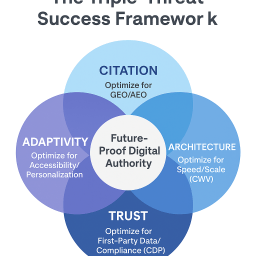The era of Google as the undisputed traffic overlord is over. This is a tectonic shift; by 2028, the majority of "answer engine" traffic is projected to come from conversational AI like ChatGPT. If your playbook is still based on traditional SEO, you're competing for a diminishing piece of the pie.
Welcome to the age of Answer Engine Optimization (AEO).
AEO is a new discipline focused on achieving citation and inclusion within generative AI systems, shifting visibility goals away from traditional keyword rankings.

🚀 Preview: The New Competitive Landscape
| Metric | The AI Threat (The Digital Siphon) | The AEO Advantage (The Citation Multiplier) |
| Organic CTR | Down 65.2% year-over-year for non-cited queries when AI Overviews appear. | 35% higher organic CTR and 91% higher paid CTR compared to non-cited competitors for the same queries. |
| Visibility Goal | Ranking on the first page. | Being cited as the authoritative source by the AI. |
| Buyer Quality | Traditional search visitors. | AI search visitors convert at three times the rate of traditional visitors. |
| Content Mandate | Broad, educational content. | Must be machine-readable (Schema markup) and unique (proprietary data). |
The Great Digital Migration: Why Your Old Strategy Is Already Obsolete
The modern buyer journey is an AI-fueled spaghetti noodle. Your strategy must adapt to this reality.
The Digital Siphon: The End of the Free Click
-
AI-generated summaries (like Google’s AI Overviews) appear in nearly six out of ten searches, successfully keeping the user on the AI’s page.
-
The Quantified Loss: Organic CTR for non-cited brands with an AI Overview fell by a massive 65.2% year-over-year, effectively neutering the ROI of high-funnel campaigns.
The Informed Buyer: The Citation Premium
Visibility loss is a choice. Brands that achieve citation within the AI answer see a dramatic reversal.
-
Citation is a competitive advantage: It results in a 35% higher organic CTR and a remarkable 91% higher paid CTR.
-
The New Buyer: More than 50% of buyers now use AI to inform their purchasing decisions. They arrive with high conviction, converting at three times the traditional rate.
-
The Content Pivot: Your broad 101 content is commoditized. Your job is to be the definitive, citable source that shapes their shortlist. Authority is now built by human engagement (YouTube, newsletters, podcasts), which AI also references.
Decoding the Algorithm: Two Concepts That Define Your AEO Strategy
To win, you must understand how the AI’s “brain” works.
A. Query Fan Out: AI’s Curiosity Engine
When a user asks a complex question, the AI activates its Query Fan Out engine, which breaks the request into a cluster of highly specific sub-questions:
-
Example: “What are the best CRM options for a small logistics company?”
-
Fan Out Sub-Queries: CRMs that integrate with shipping software, Small business CRMs under $50/month, etc.
-
Your Action: Your old “Ultimate Guide” won’t work. For every one broad guide, you need ten laser-focused pieces designed to answer these tiny, contextualized questions. This creates an atomic content cluster that mirrors the structure of AI knowledge graphs.
B. Memory and Hyper-Personalization
Every AI response is personalized based on:
-
User’s past search history and clicks.
-
Connected files (Google Drive, Asana, etc.).
-
Previous chat conversations.
-
Your Goal: To be the most relevant answer for the specific user (e.g., Margaret, the Marketing Manager).
-
Prerequisite: Unify your data (e.g., through a Smart CRM) so the AI can prioritize your offering when generating a tailored recommendation. Consumers now expect this omnichannel hyper-personalization.
The AEO Content Mandate: Clarity, Structure, and Uniqueness
Your content must be easy for the AI to “chunk” and synthesize.
The Death of the Ultimate Guide (And the Rise of Unique Data)
-
Content must be grounded in proprietary, verifiable insights that LLMs cannot synthesize from public knowledge graphs.
-
Proprietary Data is Essential: Leverage internal CRM data, customer success insights, or product usage statistics. Micro-survey results with clear summaries and bulleted findings provide unique fuel for citation.
-
AI prioritizes these verifiable facts to reduce the risk of generating a “hallucination,” making the content inherently safer and more citable.
The AEO Checklist: UX for the Algorithms
| AEO Best Practice | Why It Works (The UX/UI Angle) |
| 1. Put the Answer First | The very first sentence must completely answer the primary question (Answer-First Imperative). |
| 2. Go a Click Deeper | Follow the primary answer with two to three short, contextual paragraphs for credibility and completeness. |
| 3. Reference Original Data | Use your proprietary stats. This gives the AI unique fuel to cite and strengthens authority. |
| 4. Include a Fan-Out FAQ | Answer at least three sub-questions at the bottom, using H3/H4 headings so the AI can lift the answer effortlessly. |
| 5. Add Structure Up the Wazoo | Use explicit headers (H2s, H3s), structured lists, tables, and bullets. Design for skimmability using proper semantic HTML. |
| 6. The “Taco Bell Test” | Ensure every section, paragraph, or “chunk” can stand on its own and retain context if pulled in isolation. |
| 7. Tie Every Point Back to the Product | Reference your product or service in every other paragraph. Don’t give free educational value without linking to your solution. |
The Unseen Language of Trust: Technical Proof and Authority
The signals of trust have changed. Authority is now derived from high-context, positive, third-party validation that AI systems can ingest.
The AI’s Blueprint: Structured Data (Schema)
Schema.org vocabulary is the technical bridge that explicitly informs the AI about the content’s context and relationships.
-
Crucial Schemas:
-
FAQPageSchema: Essential for Q&A content, explicitly signaling the answer to LLMs. -
HowToSchema: Mandatory for instructional guides, marking steps clearly. -
OrganizationSchema: Clarifies corporate identity for consistent entity recognition. -
SpeakableSchema: Designates text to be prioritized by voice assistants.
-
-
Prerequisite: Implementing this markup (often via JSON-LD) reduces the AI’s risk of generating a “hallucination.” Technical health (fast page speed, Core Web Vitals) remains a functional requirement.
Authority: Why Social Proof Is the New Backlink
LLM citations are the new “backlinks of the AI era.” AI models look for high-context, positive mentions across influential third-party channels.
-
Review Platforms are Gold: Sites like G2, Capterra, and Trust Radius are incredibly “sticky” in answer engine responses. G2 accounts for a massive share of review-site citations. Dominating these platforms is an AEO mandate.
-
Target Cited Sources: Identify which third-party websites are already being cited by AI for your priority questions. Your off-site strategy should be to get a positive, context-rich mention on those exact pages.
-
Focus on Messaging: AEO prioritizes the integration of your messaging over a simple hyperlink. Ensure your product’s description accurately integrates your core positioning so the AI learns your narrative.
-
Omnichannel Proof: AI also references content from YouTube, podcasts, and community platforms like Reddit and Quora for experience-based answers.
-
E-E-A-T: AI models use Experience, Expertise, Authoritativeness, and Trustworthiness to judge credibility. This requires clear, machine-legible author bios, verifiable facts, and regular content maintenance.
✅ The Takeaway: Stop Chasing the Ghost
The future of digital demand is conversational, personalized, and demanding. This strategic AEO pivot translates into a substantial return on investment: AI-informed traffic converts up to three times higher, and strategic use of AI intent data can increase pipeline velocity by 30%.
Don’t wait until 2028. Now is the time to:
-
Map Intent and Audit Content: Implement tools for Query Fan Out analysis and transform “Ultimate Guides” into semantic clusters of atomic, answer-first content pieces.
-
Enforce Technical Structure: Mandate the use of structured content templates that enforce the Answer-First imperative and the use of question-based headings.
-
Prioritize Schema Implementation: Immediately deploy high-impact Schema types—specifically
FAQPage,HowTo, andOrganizationSchema—in JSON-LD format. -
Strengthen Authority Signals: Launch a strategic initiative to secure positive, context-rich brand mentions on top AI-cited review and publisher sites.





